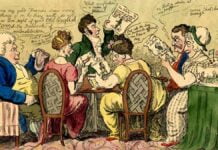Laurence Housman is a prolific playwright, writer and illustrator. Under Fire, one of the best of his one-act plays portrays a sensational episode in the life of Queen Victoria during the early period of her reign with scrupulous adherence to historical facts. The play shows Queen Victoria displaying extraordinary courage and composure in the face of a dire threat to her life.
Historical Context
Housman’s Under Fire delves into the dramatic events surrounding one of Queen Victoria’s attempted assassinations, the 1842 attack by John Francis. The play draws on a significant event in Victorian history, showcasing the anxieties and tensions surrounding the monarchy after the Reform Act and other social changes. The attempt on Victoria’s life reflects the vulnerability of the Queen as a symbol of the British Empire and the ever-present threat of dissent and rebellion.
Summary
Queen Victoria reigned England from 1837 to 1901. During the early period of her reign, multiple assassination attempts were made on her life. The Queen was composed and courageous in this dire situation. Housman brings out the Queen’s grit and humanity in the play.
The Queen visits the Park occasionally, and there would be a massive gathering of people outside Buckingham Palace to get her glimpse. The police suspect that there will be an attempt of assassination and advise the Queen to cancel her customary ride to the Park.
Prince Albert, the husband of the Queen, is her greatest source of strength. The last time the Queen and Prince Albert rode to the Park, there was an assassination attempt, and she escaped miraculously. When Prince Albert informed the Queen about how she was facing the other way when the assassin had misfired his pistol, she was not alarmed but was surprised that any of her subjects would think of murdering her.
Queen Victoria is not afraid and acts sensibly. She feels like going to war when she prepares to leave for the Park. She is excited, but Prince Albert tells her to hide her excitement. They risk going to the Park to give the police a fair chance to catch the assassin.
Queen Victoria has two ladies-in-waiting, Lady Muriel and Lady Grace. A lady-in-waiting is a female personal assistant of the royal woman. Usually, they would accompany the royal couple to the Park, but on that day, the Queen asked them not to be with her. The ladies are annoyed and upset because they cannot show off their new hat and shawl to the crowds outside the palace. They start talking rubbish about her since they misunderstood the Queen’s concern for them. They criticise the Queen and gossip about the royal couple.
Halfway to the Park, the assassination attempt against the Queen takes place. Luckily, the royal couple are unharmed and return to the safety of the palace, where they meet the remorseful ladies. Now, the ladies have understood why the Queen kept them from accompanying her to the Park. The Queen asks them to leave quickly, but Lady Muriel asks the Queen’s forgiveness and kisses her hand. The Ladies are ashamed of themselves for badmouthing about their thoughtful and loving Queen.
When the royal couple are left alone, they share their inner feelings, which brings out their human side. They are depicted as a vulnerable and strong couple at the same time. Prince Albert was afraid that the assassin would achieve his mission and he would lose his wife. The Queen suddenly recognises that she has not considered the possibility of losing her husband, to which the Prince comments that the Queen should not think of others. The Queen speaks and acts in a matter-of-fact, realistic manner. She is shown as someone with her head in the right place and is not carried away by her powerful position.
Analysis
Housman focuses on the emotional and psychological impact of the assassination attempt on both Victoria and her close circle. We see the Queen’s initial disbelief and shaken composure as she grapples with the near-death experience.
Ultimately, the play transcends the specific historical incident, exploring broader themes of vulnerability, courage, and the weight of responsibility upon a monarch. The ending, though ambiguous, leaves a lasting impression on the audience, prompting reflection on how individuals cope with life-threatening situations and the nature of leadership in the face of crisis.
Housman portrays Queen Victoria as a complex figure – both stoic and vulnerable, regal yet grappling with human fear. The play mirrors different facets of Queen Victoria’s character. Despite being ‘under fire’, she shows no sign of panic in a crisis. Her initial shock and trembling gradually give way to a determined resolve as she continues the parade, prioritising her public duty over personal safety. She is kind and considerate and bears no ill will, even to the offender. Prince Albert emerges as a pillar of support, offering comfort and reassurance to his shaken wife while maintaining a calm and decisive demeanour in the face of chaos. Queen Victoria jealously adores her husband, who stands by her as a tower of strength in her hour of need.
The exultant behaviour of the crowd at the Queens’s narrow escape from the assassin’s bullet reveals an interesting aspect of the royalty worship of the British subjects. The safety of their monarch is of utmost importance to them, for they seem to identify the Queen’s safety with that of their own.
Themes
Vulnerability and Strength
The play highlights the paradox of power and vulnerability inherent in the life of a monarch. Despite her position, Victoria remains susceptible to human emotions and the threat of violence.
Courage and Leadership
Even amidst fear, Victoria courageously decides to carry on with the parade, setting an example for her people and showcasing the strength expected of a leader.
Public vs. Private Self
The play explores the conflict between the public image of the Queen and the emotional turmoil she experiences privately. Victoria’s journey reflects the challenges of maintaining composure under public scrutiny.
Fate and Control
The randomness of the assassination attempt raises questions about destiny and our limited control over life’s events.
Under Fire remains a poignant and thought-provoking exploration of human experience through the lens of a historical event. By capturing the emotional and psychological journey of Queen Victoria and her entourage, Housman offers a deeper understanding of the fragility of power, the complexities of leadership, and the resilience of the human spirit in the face of danger.






























